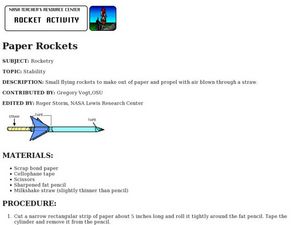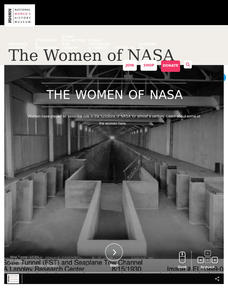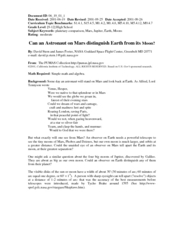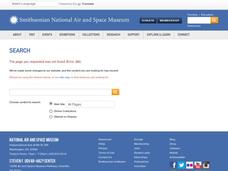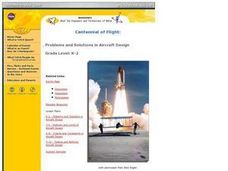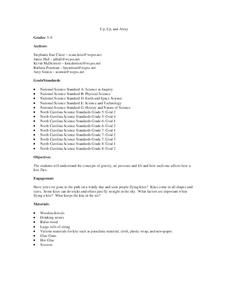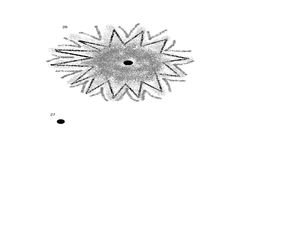Curated OER
Soda Straw Rocket Activity
Students construct a rocket using soda straw. In this physics lesson, students determine the nose cone length that produces the best rocket. They explain the importance of using a control in an experiment.
Curated OER
Paper Rockets
Students design, construct, and fly paper rockets that travel the greatest distance possible across a floor model of the solar system. They construct small flying rockets out of paper and propel them by blowing air through a straw.
Curated OER
Altitude Tracking
Students construct simple altitude tracking devices for determining the altitude a rocket reaches in its flight. They estimate the altitude a rocket achieves during flight.
National Woman's History Museum
The Women of NASA
Human computers? Although it may sound like science fiction, the term was used to describe the women who made the NASA calculations before the advent of electronic computers. A 21-slide presentation introduces viewers to the women who...
Curated OER
The Learning Network Fill-In: When the Food Writer Is a Ghost
Introduce your class to ghostwriting while practicing comprehension. From The New York Times' The Learning Network, this article covers the topic of ghostwriting for cookbooks. There are blank spaces and a word bank. Learners can use the...
Curated OER
Great Explorations: To the End of the Earth and Beyond
Young scholars analyze the factors that affect exploration such as religion, trade, territorial expansion, and science. In this Great Explorations lesson, students determine the names of famous explorers as well as their routes and...
Curated OER
Can an Astronaut on Mars Distinguish Earth from its Moon?
High schoolers explore the possibility of being on Mars and being able to identify the Earth. In this space lesson students complete a set of calculations to see if this is possible.
Curated OER
Stories of the Wrights' Flights
Students examine primary sources to understand the work of Wright Brothers. In this aviation history lesson, students study how primary documents and images are analyzed and write essays about the signifcance of primary soures in...
Curated OER
Flying Through the Solar System
Learners create a model of the solar system out of candy. They write a book about their travels through the Solar System, beginning at age ten and reaching Pluto at age seventy.
Curated OER
Moon, Mars, and Beyond-Mission Briefing
Students complete this introductory lesson in which they find out about the scenario for a simulated online space mission. They review vocabulary and complete a review sheet to reinforce the details of the mission and its goals.
Curated OER
From Airmail to Airlines
Students explore changes in air transportation from 1920 to the present. In this air flight lesson plan, students are introduced to the history of air transportation. This lesson plan contains three different activities that will...
Curated OER
Problems and Solutions in Aircraft Design
Young scholars watch demonstrations of paper folded designs that do and do not fly and discuss their observations. They identify problems that they, the Wright Brothers, or NASA scientists face when designing an aircraft, and identify...
Curated OER
Time Zones
In this time zones worksheet, students complete the total length of trips for time zones and answer short answer questions. Students fill in 3 spaces in the chart and answer 3 questions.
Curated OER
Up, Up and Away
Tenth graders experiment with gravity and air pressure. In this geometry lesson, 10th graders build their own kits and fly it. They investigate the questions: what keeps a kite in the air and what are some important factors when flying a...
Curated OER
Go Fly a ( Tetrehedral) Kite!
Young scholars research the tetrahedral kites invented by Alexander Graham Bell. In this components of flight lesson, students examine the kites made by Bell and his team. Young scholars create their own kite and add them together as a...
Curated OER
What is Momentum?
In this momentum activity, students will calculate the maximum forward momentum of the Apollo 11 lunar spacecraft at three different stages of its space travel.
Curated OER
Rocket Science
Students conduct an experiment. In this physical science lesson, students learn about Isaac Newton's theory that for every action there is an equal but opposite reaction. Students show this theory by looking at how a rocket is propelled...
Curated OER
Airplanes and Airports: How To Take Off Without Ever Leaving the Ground
Students plan an airport visit. For this Airplanes and Airports lesson, students observe the people, activity, and machinery at airports. Then students compare the characteristics of their observations at the airport. Students make...
Curated OER
A Peek into the Lives of Stars!
Students create a model of the birth of a star and demonstrate the stages of the star's lifecycle. In this star lifecycle lesson, students mix flour and water in a jar to model the birth of a star, then role-play the entire...
Curated OER
Wright Flight
Students explain and explain the interactive relationships between forces of lift and gravity, thrust and drag, as they apply to airplanes in motion. They know that Orville and Wilbur Wright flew the first airplane based on these...
Mathed Up!
Nets, Plans, and Elevations
A dimensional resource teaches viewers to recognize 2-D views of 3-D objects and how to match nets with their 3-D figures. Individuals draw different views of three-dimensional objects including views from the front, side...
Class Antics
Leap Year
What is a Leap Year and why do we have it? Find out with this Leap Day/Leap Year response to reading worksheet in which scholars read a short passage and use their new-found knowledge to answer five questions with short...
Curated OER
Move Your Muscles!
Students, through teacher lecture and class discussion, explore the three different types of muscles in the human body and the effects of microgravity on these muscles. They explain what happens to muscles in outer space and describe the...
Curated OER
Look Ma! I'm a Rocket Scientist!
Students use a ball to push and pull to demonstrate the concept of force. In this force lesson plan, students talk about the importance of force in space and use balls to demonstrate this phenomena.
Other popular searches
- Space Shuttle Flight Path
- Manned Space Flight
- Space Flight History
- History of Space Flight
- Human Space Flight
- \"Manned Space Flight
- "Manned Space Flight
- \\"Manned Space Flight
- \\\"Manned Space Flight
- American Space Flights
- Space Flight Report



